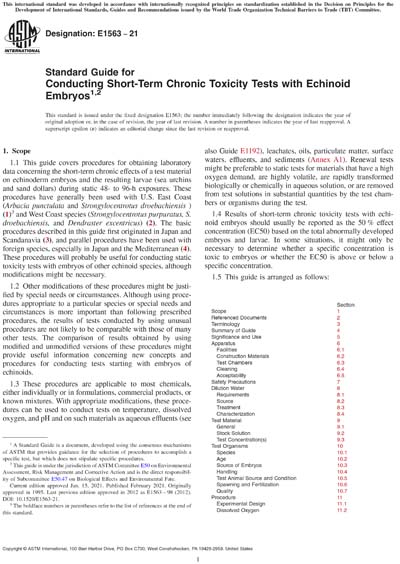Historical
ASTM E1563-21
Standard Guide for Conducting Short-Term Chronic Toxicity Tests with Echinoid Embryos
1.1 This guide covers procedures for obtaining laboratory data concerning the short-term chronic effects of a test material on echinoderm embryos and the resulting larvae (sea urchins and sand dollars) during static 48- to 96-h exposures. These procedures have generally been used with U.S. East Coast (Arbacia punctulata and Strongylocentrotus droebachiensis ) (1)3 and West Coast species (Strongylocentrotus purpuratus, S. droebachiensis, and Dendraster excentricus) (2). The basic procedures described in this guide first originated in Japan and Scandanavia (3), and parallel procedures have been used with foreign species, especially in Japan and the Mediterranean (4). These procedures will probably be useful for conducting static toxicity tests with embryos of other echinoid species, although modifications might be necessary.
1.2 Other modifications of these procedures might be justified by special needs or circumstances. Although using procedures appropriate to a particular species or special needs and circumstances is more important than following prescribed procedures, the results of tests conducted by using unusual procedures are not likely to be comparable with those of many other tests. The comparison of results obtained by using modified and unmodified versions of these procedures might provide useful information concerning new concepts and procedures for conducting tests starting with embryos of echinoids.
1.3 These procedures are applicable to most chemicals, either individually or in formulations, commercial products, or known mixtures. With appropriate modifications, these procedures can be used to conduct tests on temperature, dissolved oxygen, and pH and on such materials as aqueous effluents (see also Guide E1192), leachates, oils, particulate matter, surface waters, effluents, and sediments (Annex A1). Renewal tests might be preferable to static tests for materials that have a high oxygen demand, are highly volatile, are rapidly transformed biologically or chemically in aqueous solution, or are removed from test solutions in substantial quantities by the test chambers or organisms during the test.
1.4 Results of short-term chronic toxicity tests with echinoid embryos should usually be reported as the 50 % effect concentration (EC50) based on the total abnormally developed embryos and larvae. In some situations, it might only be necessary to determine whether a specific concentration is toxic to embryos or whether the EC50 is above or below a specific concentration.
1.5 This guide is arranged as follows:
1.6 The values stated in SI units are to be regarded as the standard.
1.7 This standard does not purport to address all of the safety concerns, if any, associated with its use. It is the responsibility of the user of this standard to establish appropriate safety and health practices and determine the applicability of regulatory limitations. Specific precautionary statements are given in Section 7.
1.8 This international standard was developed in accordance with internationally recognized principles on standardization established in the Decision on Principles for the Development of International Standards, Guides and Recommendations issued by the World Trade Organization Technical Barriers to Trade (TBT) Committee.
Content Provider
ASTM International [astm]






